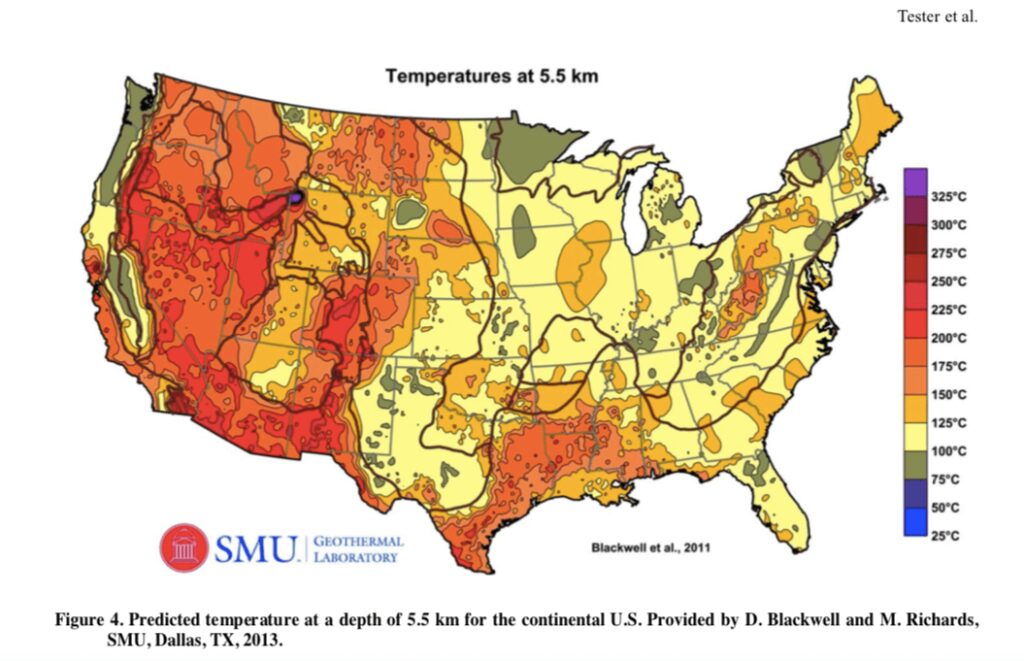For Baseload Energy with No Carbon Emissions, Look (Way) Down
By Evelyn Teel
When discussing renewable energy, the conversation often revolves around wind and solar. These are very visible energy sources – we often see solar panels in our neighborhoods or wind turbines on hilltops. However, there are many other types of renewable energy resources operating or being developed around the world.
As we try to increase the percentage of renewable energy in the mix, it will be essential to develop technologies that balance each other’s strengths and weaknesses. One of the biggest challenges with wind and solar is their intermittent nature – they will not be able to provide dispatchable power until significant improvements have been made in energy storage technology.
One energy resource that is available throughout the country on a constant basis is the heat that exists in the earth’s crust. In some parts of the country, such as Northern California, high temperatures are found fairly close to the surface, and this geothermal source is used to generate electricity. Outside of the United States, Iceland has significant geothermal resources, which are used to heat 90% of their households as well as for many other uses (https://nea.is/geothermal/direct-utilization/).
Geothermal is actually a very old source of energy for humans. We have used hot springs for warmth and healing for tens of thousands of years. More than a hundred and twenty-five years ago, the first geothermal district heating system was created in Boise, Idaho, where it heated homes and businesses. In 1904, the first geothermal power plant was developed in Tuscany, Italy (https://www.energy.gov/eere/geothermal/history-geothermal-energy-america). Recent and ongoing advances are increasing the range of locations in which geothermal energy can be accessed and used.
The temperature gradient, or rate at which temperature increases as you drill farther into the crust, is not consistent throughout the country. In some areas it is necessary to drill much farther before reaching the temperatures generally required to use geothermal energy to produce electricity. However, innovators are working to hone the techniques and technologies that will allow this renewable resource to be leveraged in more areas. This means developing the capacity to drill farther into the ground, or learning to work with lower temperature geothermal resources. If the geothermal heat is intended to be used for space or water heating, it generally does not need to be at quite as high a temperature as would be required for generating electricity.
The graphic below, from the paper “Integrating Geothermal Energy Use into Re-building American Infrastructure” by Jeff Tester, Tim Reber, Koenraad Beckers, Maciej Lukawski, Erin Camp, Gloria Andrea Aguirre, Terry Jordan and Frank Horowitz, presented at the World Geothermal Congress 2015 (https://pangea.stanford.edu/ERE/db/WGC/papers/WGC/2015/38000.pdf), shows estimated temperatures throughout the United States at a depth of 5.5km. As you can see, by that depth (just less than 3.5 miles), much of the country is estimated to be at a temperature of at least 125 degrees Celsius, which is sufficient for space heating, water heating, and other purposes.

The logistics of an enhanced geothermal system (or one in which water is pumped into the ground to be heated) entail drilling two wells in parallel, several miles into the ground. Water is pumped into one well; once it reaches the bottom, it is warmed by the surrounding rocks. The heated water is then pumped back up the second well. Depending on the temperature, the water may be so hot that it comes out as steam that can be used to turn a turbine to generate electricity, or it may pass through a heat exchanger so that it warms another fluid that is then used to heat buildings or put to other uses.
At Cornell University, researchers are working to develop an enhanced geothermal system, also called Earth Source Heat, that could heat the campus’s buildings using (relatively) low temperatures such as are available throughout much of the country. Though further research and testing are still required, demonstrating the efficacy of such a system could open the door for further deployment of such systems around the country and the world. For more information on the work happening at Cornell, check out their website: https://earthsourceheat.cornell.edu/.
Geothermal energy is often confused with applications involving ground source heat pumps. However, the two are very different. Geothermal energy involves extracting heat from the earth. Some of this heat remains from the original formation of the earth. Some is a result of the radioactive decay over millions of years of elements deep within the earth. Geothermal energy applications are large scale projects that tap into this heat source through wells drilled several miles below the surface of the earth. Ground source heat pumps, on the other hand, are much smaller applications that use the relatively constant temperature of the near subsurface of the earth (10 to 500 feet) as a heat sink for residential and small commercial heating and cooling applications.
Moving to a renewables-based energy mix will require a variety of resources that complement one another and serve the full range of energy needs throughout the country and the world. Geothermal energy has quite a few positives, including that it can provide baseload power, it generates no carbon and basically no pollution, and the generation sites require a very small footprint. It is a great complement to the more intermittent sources of energy as well as those that are only available in limited geographic areas. This is quite an exciting time, as we witness the resurgence of old energy sources and the development of new ones.
Interested in learning how you can benefit from today’s low energy prices? Call or email us today and we’d be happy to help you explore your options.
The Avalon Advantage – Visit our website at www.avalonenergy.us, call us at 888-484-8096, or email us at info@avalonenergy.us.
Please feel free to share this article. If you do, please email or post the web link. Unauthorized copying, retransmission, or republication is prohibited.
Copyright 2020 by Avalon Energy® Services LLC
